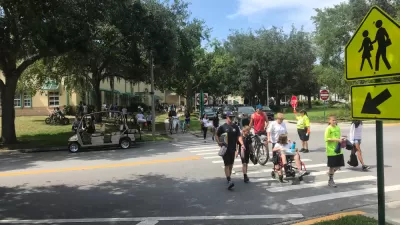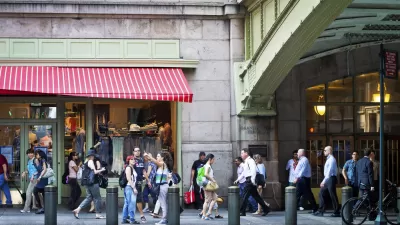A spate of high profile pedestrian deaths have New Yorkers wondering just how safe it is to traverse their city on foot.
In the last month in New York, a woman was killed when a Honda sport utility vehicle "careered onto the sidewalk" where she was walking and "a 6-year-old boy walking to school with his brother was killed when a tractor-trailer turned right onto First Avenue from 117th Street in East Harlem, hitting him," writes Ginia Bellafante.
"When events like this happen sequentially, taking on the cast of epidemic, it is reasonable to ask just how safe walking really is in New York. According to newly released data from the Tri-State Transportation Campaign, a nonprofit group that works to reduce car dependence, there were 451 pedestrian fatalities in the city between 2009 and 2011, fewer than the number of homicides in 2011."
"However much we might seem uniquely susceptible to pedestrian fatality in a place where so much of life transpires on foot, New York still turns out to be a safer place to walk than most other big cities in the country," she adds. "In a ranking of metropolitan areas with populations of one million people or more, Transportation for America, another advocacy group, listed New York at No. 50 — behind Orlando, Miami, Denver, Chicago, Austin and San Francisco — in terms of the number of pedestrian deaths for every 100,000 people. This was true even though New York had the highest percentage of people — 6.1 percent — walking to work."
But does this mean the city can't do more to enhance the safety of pedestrians? Transportation Alternatives and Scott M. Stringer, the Manhattan borough president, have some ideas.
FULL STORY: Is It Safe to Cross?

Planetizen Federal Action Tracker
A weekly monitor of how Trump’s orders and actions are impacting planners and planning in America.

Map: Where Senate Republicans Want to Sell Your Public Lands
For public land advocates, the Senate Republicans’ proposal to sell millions of acres of public land in the West is “the biggest fight of their careers.”

Restaurant Patios Were a Pandemic Win — Why Were They so Hard to Keep?
Social distancing requirements and changes in travel patterns prompted cities to pilot new uses for street and sidewalk space. Then it got complicated.

DC Area County Eliminates Bus Fares
Montgomery County joins a growing trend of making transit free.

Platform Pilsner: Vancouver Transit Agency Releases... a Beer?
TransLink will receive a portion of every sale of the four-pack.

Toronto Weighs Cheaper Transit, Parking Hikes for Major Events
Special event rates would take effect during large festivals, sports games and concerts to ‘discourage driving, manage congestion and free up space for transit.”
Urban Design for Planners 1: Software Tools
This six-course series explores essential urban design concepts using open source software and equips planners with the tools they need to participate fully in the urban design process.
Planning for Universal Design
Learn the tools for implementing Universal Design in planning regulations.
Heyer Gruel & Associates PA
JM Goldson LLC
Custer County Colorado
City of Camden Redevelopment Agency
City of Astoria
Transportation Research & Education Center (TREC) at Portland State University
Camden Redevelopment Agency
City of Claremont
Municipality of Princeton (NJ)





























